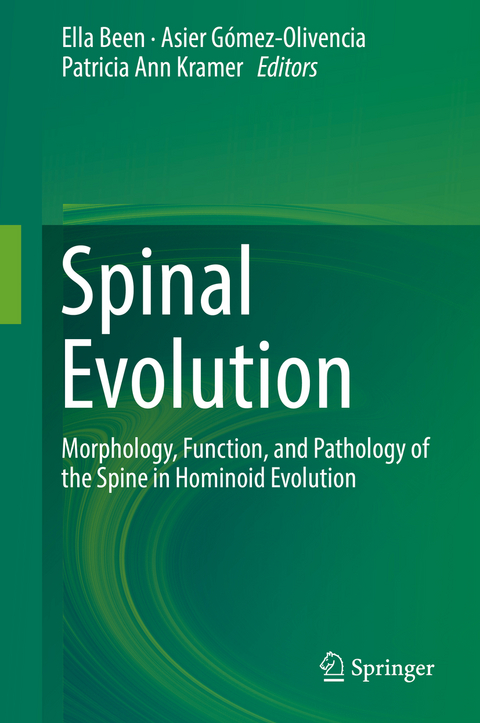
Spinal Evolution
Springer International Publishing (Verlag)
978-3-030-19348-5 (ISBN)
The vertebral spine is a key element of the human anatomy. Its main role is to protect the spinal cord and the main blood vessels. The axial skeleton, with its muscles and joints, provides stability for the attachment of the head, tail and limbs and, at the same time, enables the mobility required for breathing and for locomotion. Despite its great importance, the vertebral spine is often over looked by researchers because: a) vertebrae are fragile in nature, which makes their fossilization a rare event; b) they are metameric (seriated and repeated elements) that make their anatomical determination and, thus, their subsequent study difficult; and c) the plethora of bones and joints involved in every movement or function of the axial skeleton makes the reconstruction of posture, breathing mechanics and locomotion extremely difficult.
It is well established that the spine has changed dramatically during human evolution. Spinal curvatures, spinal load transmission, and thoracic shape of bipedal humans are derived among hominoids. Yet, there are many debates as to how and when these changes occurred and to their phylogenetic, functional, and pathological implications.
In recent years, renewed interest arose in the axial skeleton. New and exciting finds, mostly from Europe and Africa, as well as new methods for reconstructing the spine, have been introduced to the research community. New methodologies such as Finite Element Analysis, trabecular bone analysis, Geometric Morphometric analysis, and gait analysis have been applied to the spines of primates and humans. These provide a new and refreshing look into the evolution of the spine. Advanced biomechanical research regarding posture, range of motion, stability, and attenuation of the human spine has interesting evolutionary implications. Until now, no book that summarizes the updated research and knowledge regarding spinal evolution in hominoids has been available. The present book explores both these new methodologies and new data, including recent fossil, morphological, biomechanical, and theoretical advances regarding vertebral column evolution. In order to cover all of that data, we divide the book into four parts: 1) the spine of hominoids; 2) the vertebral spine of extinct hominins; 3) ontogeny, biomechanics and pathology of the human spine; and 4) new methodologies of spinal research. These parts complement each other and provide a wide and comprehensive examination of spinal evolution.
Ella Been, PT, PhD. Department of Sports Therapy, Faculty of Health Professions, Ono Academic College, Kiryat Ono 55107, Israel Department of Anatomy and Anthropology, Sackler Faculty of Medicine, Tel Aviv University, Tel Aviv 69978, Israel E mail: beenella1@gmail.com. Phone: 972-52-3353890 Asier Gomez Olivencia, PhD. Dept. Estratigrafía y Paleontología, Facultad de Ciencia y Tecnología, Universidad del País Vasco/Euskal Herriko Unibertsitatea (UPV/EHU). Barrio Sarriena s/n, 48940 Leioa, Spain IKERBASQUE. Basque Foundation for Science. Centro UCM-ISCIII de Investigación sobre Evolución y Comportamiento Humanos, Avda. Monforte de Lemos 5 (Pabellón 14), 28029 Madrid, Spain. E mail: asiergo@gmail.com. Phone: +34 627337043 (cell phone) / +34 946012053 (office) Patricia Kramer, PhD Departments of Anthropology and Orthopaedics & Sports Medicine, University of Washington, Box 353100, Seattle, WA, USA 98195-3100 E mail: pakramer@uw.edu. Phone: 1-206-616-2449 (lab)/ 1-206-650-6407 (cell)
0 Yoel Rak. Introduction.- Hominoids.- 1 Gabrielle E. Russo, Cranial base in Hominoids in relation to posture and locomotion.- 2 Thierra K. Nalley, Neysa Grider-Potter, Mikel Arlegi, Vertebral morphology in hominoids, posture and locomotion: I-the cervical spine.- 3 Liza Shapiro, Vertebral morphology in hominoids, posture and locomotion: II-the thoracic and the lumbar spine.- 4 Masato Nakatsukasa, The spinal plasticity: changes in spinal morphology due to locomotor changes: the example of Japanese macaques.- Modern humans.- 5 Jeannie Bailey, Patricia Kramer, Lumbar lordosis and motion: implications for fossil hominins.- 6 Eric Castillo, Dan Lieberman, Biomechanical models of the spine, evolutionary perspective.- 7 Leonid Kalichman, Ella Been, Spinal posture and spinal pathology in modern humans.- 8 Katherine Whitcome, Sexual dimorphism of the axial skeleton.- 9 Sandra Martelli, Spinal ontogeny and evolution.- Methodology.- 10 Ella Been, Reconstruction of the spinal curvatures based on skeletal material.- 11 Markus Bastir, The use of geometric morphometrics in the study of the human spine.- 12 Kate Robson Brown, Infant vertebral cancellous bone ontogeny (Neanderthals and modern humans).- 13 Patricia Kramer, Finite Element Analysis of the vertebral spine- implications to human evolution.- Extinct hominins.- 14 Scott Williams, The spine of Australopith.- 15 Marc Meyer, The spine of Early Homo.- 16 Asier Gómez-Olivencia, Ella Been, The spine of Late Homo.- 17 Martin Haeusler, Spinal paleopathology in hominins.- Final chapter, Been et al., Future perspectives into the study of the human spine and its evolution.
| Erscheinungsdatum | 22.08.2019 |
|---|---|
| Zusatzinfo | X, 407 p. 86 illus., 62 illus. in color. |
| Verlagsort | Cham |
| Sprache | englisch |
| Maße | 155 x 235 mm |
| Gewicht | 787 g |
| Themenwelt | Naturwissenschaften ► Biologie ► Evolution |
| Schlagworte | hominoids • Locomotion • Model vertebrates • Pathology • Posture • Vertebral spine |
| ISBN-10 | 3-030-19348-9 / 3030193489 |
| ISBN-13 | 978-3-030-19348-5 / 9783030193485 |
| Zustand | Neuware |
| Haben Sie eine Frage zum Produkt? |
aus dem Bereich


